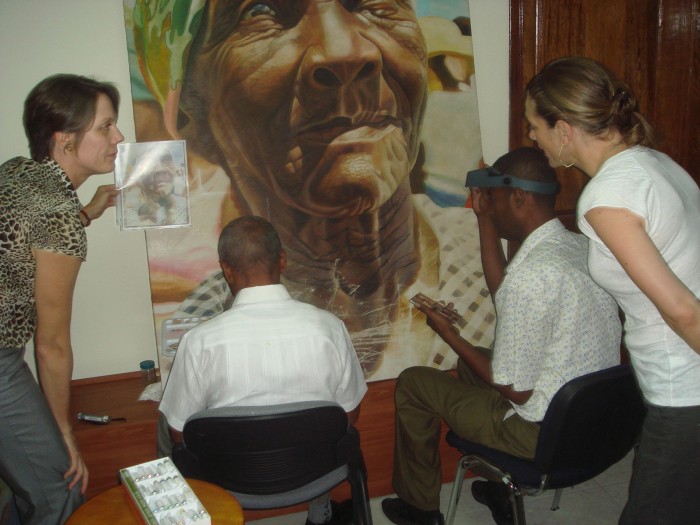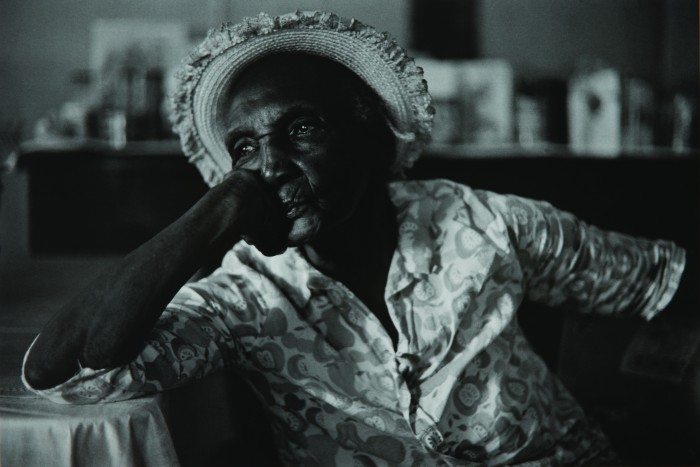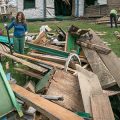Cultural Heritage Preservation: Protecting the past from the present
The Smithsonian preserves things: from stories to species, from artifacts to artworks. Coral and plant samples are cryogenically preserved. Languages in danger of being lost are meticulously studied, detailed and safeguarded for future generations. Priceless paintings worn by the ravages of time are painstakingly restored to their original beauty. Asian elephants are tracked and conserved using satellites in Myanmar. And now, the talents of Smithsonian experts are being increasingly directed to the preservation of the history and culture of people across the country and around the world. I sat down for a chat with our Cultural Heritage Preservation Officer Cori Wegener and Acting Provost/Under Secretary for Museums and Research Richard Kurin to learn more about the Smithsonian’s role in preserving the heritage of cultures threatened by disaster and destruction, whether natural or manmade.
The Smithsonian has a long history of working to protect the United States’ priceless cultural artifacts from damage and decay. But the 2010 earthquake in Haiti was a huge collaborative international effort to protect tangible cultural artifacts abroad. What did we learn from that project?
Kurin: Following the devastating earthquake, the Smithsonian turned humanitarian empathy into institutional action. A number of key leaders, including Johnnetta Cole (director of the African Art Museum) and Lonnie Bunch (director of the National Museum for African American History and Culture), knew how important Haitian heritage was to U.S. and world history and why it had to be saved. Given our conservation and collection management expertise we had the technical capacity to help do so. Our standing gave us the ability to mobilize U.S. government agencies, professional organizations, international partners and donors. Our prior cultural work in Haiti gave us strong ties to colleagues and leaders there. Cori Wegener, who then worked for the Minneapolis Institute for the Arts, provided the spark. She was a genuine “monuments woman,” having served as a U.S. Army Civil Affairs Officer helping to save the Iraqi museum in Baghdad. She challenged the museum and heritage community to do something. We answered her call. The Smithsonian raised about $4 million, hired a Haitian staff, rented a building in Port-au-Prince, installed conservation labs, deployed some 70 experts—about half from the Smithsonian, half from partners—in order to save some 35,000 artworks, artifacts, rare books and historical archives and provide preservation training to 150 Haitians from dozens of cultural organizations. We’ve now helped Quisqueya University build a new Cultural Conservation Center for training and future work.
The Haiti project demonstrated our ability to gain government support, mobilize local and international expertise, raise funds, and produce dramatic, large-scale results in a tough situation. We brought Cori to the Smithsonian, and our success led to calls for the Smithsonian to help in the wake of terrorism in Mali, Egypt and Tunisia, heritage destruction in Syria and Iraq, the earthquake in Nepal, and hurricane Sandy in New York. We are now using projects in Haiti and these other locations to develop a stronger and more effective way of helping people preserve their heritage when threatened by natural disaster and human conflict.

Haitian artists restoring a damaged masterpiece under the supervision of Stephanie Hornbeck and Rachel Goslins as part of the Haitian Cultral Recovery Project. (Photo by Wayne Clough)
Cori, as our Cultural Heritage Preservation Officer, you are on the front lines of our efforts to protect and preserve cultural heritage. In natural disasters or wars, why do you think it is important for rescue efforts to extend to the culturally significant objects of a country as well as to its people?
Wegener: After a disaster, helping people in response and recovery should always come first, but often helping people save their heritage is overlooked in the humanitarian response. At the Smithsonian, we know that cultural heritage is a key part of our daily lives, but it’s even more important when a community is struggling to come back from a disaster. Of course, people want their families to be safe and have their basic needs met, but the next thing they turn to is hope of salvaging their irreplaceable family heirlooms and community heritage. Collections and historic places, music, language and ritual—cultural heritage—underlies a community’s sense of identity. Saving their heritage can also give people hope for the future and help speed post-disaster recovery, creating more disaster-resilient communities. This video on our cultural heritage website explains more about the importance of saving heritage in disasters.
We have talked about some of our international efforts, but could you expound on our role in the preservation of our national cultural heritage?
Kurin: The “regular” everyday work of the Smithsonian is preservation—it’s what we do in our museums and in caring for our collections. We advise and train museum people and professionals through various conservation programs, fellowships, internships, workshops, publications and presentations. Our work continually informs colleagues in the museum security and facilities fields across the country. We cooperate closely with other agencies and organizations, such as the National Park Service, the National Endowment for the Arts and for the Humanities, the National Science Foundation, the Library of Congress, the American Alliance of Museums and others to craft policies, develop best practices and implement projects to save sculpture, rare books, sound recordings, natural specimens, historical artifacts in our museums, as well as in museums and cultural sites across the U.S. Responding in a crisis is a special case of this ongoing work and is based upon the fundamental belief that collections are valuable resources that enable us to understand our past and inspire us to create and shape a better future.

Miss Bertha, 1977. This photo by Jeanne Moutoussamy-Ashe (American, b. 1952) is one of 61 black-and-white photographs featuring Daufuskie Island, a unique national landmark off the South Carolina coast inhabited by a community whose distinctive language and culture remained strongly influenced by their African heritage. The collection, an important historical record of the last bastion of Gullah/Geechee tradition, will be installed at the National Museum of African American History and Culture, which is scheduled to open later this year.
Cori, you worked in this field for years before you partnered with us on the Haiti project and subsequently came to work here full time. What unique capabilities do you think the Smithsonian brings to the table?
Wegener: The Smithsonian has an amazing group of dedicated professionals with a broad array of expertise that has applications in disaster research, planning, training and response. Conservators are critical when assessing damage and treatment for collections, but we also need expertise from collections managers and registrars, facilities and operations staff, security and safety managers, librarians and archivists, and even geographic information systems mapping experts.
The Smithsonian is also a strong research institution. Our research in areas such as climate change, conservation science, and preservation can contribute to understanding good disaster preparation and response both for our own collections as well as the larger field of disaster management.
And finally, the Smithsonian Institution is a name known around the world for its quality programs and dedication to preservation. Out in the field, that reputation can build critical relationships quickly and gain valuable time to help save heritage.
Priceless antiquities face a range of threats today—war, terrorism, climate change, natural disaster. What do you think is the paramount challenge we have to overcome?
Kurin: We need to plan better so that we are proactive rather than reactive in responding to threats and crises. Cultural response efforts are largely ad hoc, even when organized by governments, international agencies and non-governmental organizations. We desperately need stronger research to understand the danger from natural and manmade threats. We need better organization and coordination among those who can respond, more training and planning ahead of time, and of course, money to mount operations quickly and effectively. We need to develop something like “Culture Without Borders,” along the lines of the aid organization Doctors Without Borders.

Volunteers covered mosaics in the Ma’arra Museum in Syria with a protective layer of glue and cloth designed to fortify and keep the tesserae together and protect the ancient mosaics from further damage caused by the ongoing conflict in that country. Several truckloads of sandbags were then laid out to protect the mosaics from damage caused by further attacks. (Image courtesy Penn Cultural Center at the University of Pennsylvania Museum)
What role does digitization play in preserving culture for future generations?
Kurin: Digitization creates records and images or facsimiles of original artifacts in our and others’ collections that can then be widely distributed, studied and appreciated well into the future. As original items decay, are lost, or sadly, are destroyed, they can be gone forever. Digitized versions can’t fully replace them—but with sophisticated technologies like 3D imaging and printing, digitization is becoming increasingly useful and having more impact in preserving our cultural memory.
We recently partnered with the Federal Emergency Management Agency (FEMA) on the Heritage Emergency National Task Force. What is this project about?
Wegener: The Heritage Emergency National Task Force (HENTF) is a network of more than 40 government and non-profit organizations dedicated to protecting cultural heritage from the damaging effects of natural disasters and other emergencies here in the U.S. HENTF is part of the national framework on disaster response and works to facilitate identification of organizations and individuals that can provide impact-assessment assistance to cultural institutions, subject-matter experts for cultural resources and historic properties, and online resources and tools to help localities, states and tribes mitigate risk. As just one example, after Hurricane Sandy, the Smithsonian worked with other HENTF members to provide much needed conservation supplies and conservation advice to institutions in New York. The Smithsonian has been a member of the Task Force for more than 20 years, but recently became the co-chair, along with FEMA. This role was previously held by Heritage Preservation, a nonprofit organization that ceased operation earlier this year. Lori Foley, administrator of HENTF and a FEMA employee, has been detailed to the Smithsonian for two years, to help implement this new agreement.
At the end of May, the Smithsonian will for the first time host the training course, First Aid to Cultural Heritage in Times of Crisis. Cori, as a past contributor to this annual event, can you explain how this program will contribute to the Smithsonian’s efforts?
Wegener: First Aid to Cultural Heritage in Times of Crisis was developed by the International Centre for the Study of the Preservation and Restoration of Cultural Property in Rome in an effort to train an international group of First Aiders. The course imparts practical skills and knowledge for taking simple measures to secure and stabilize endangered sites or artifacts during a complex emergency situation, which in turn, can become a driver for peace and future development. International instructors will provide strategies for interlocking culture specialists with humanitarian specialists during an emergency situation with the aim of unifying these sometimes conflicting perspectives. The content will be enriched through case studies on safeguarding cultural heritage from disasters ranging from Hurricane Katrina to the conflict in Syria, with the international participants adding their own experiences.
There have been four international and several regional and national editions of the training in Europe, the Middle East and Asia. As one of the instructors who helped develop the course back in 2010, I’m really excited to host the course here in the U.S. at the Smithsonian alongside colleagues from other federal and local institutions. The month-long course culminates in a realistic disaster response exercise. Here is a terrific video of the 2015 First Aid exercise in The Netherlands.
Posted: 4 January 2016








